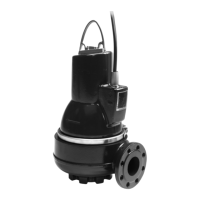English (GB)
33
11. Fault finding
DANGER
Crushing of hands
Death or serious personal injury
- Before attempting to diagnose any fault,
make sure that the fuses have been
removed or the main switch has been
switched off. Make sure that the power
supply cannot be accidentally switched
on.All rotating parts must have stopped
moving.
All regulations applying to pumps installed
in potentially explosive environments must
be observed.
Make sure that no work is carried out in
potentially explosive atmosphere.
For pumps with sensor, start fault finding
by checking the status on the IO 113 front
panel.
See installation and operating instructions
for IO 113.
Fault Cause Remedy
1. The motor does not
start.
The fuses blow or the
motor-protective
circuit breaker trips
immediately.
Caution: Do not start
again!
a) Supply failure; short circuit;
earth-leakage fault in cable or
motor winding.
Have the cable and motor checked and
repaired by a qualified electrician.
b) The fuses blow due to use of the
wrong type of fuse.
Fit fuses of the correct type.
c) The impeller is blocked by
impurities.
Clean the impeller.
d) Air bells, float switches or
electrodes are out of adjustment
or defective.
Readjust or replace the air bells, float
switches or electrodes.
e) Moisture in the stator housing
(alarm).
IO 113 interrupts the supply
voltage.*
Replace the O-rings, the shaft seal and
moisture switch.
f) The WIO sensor is not covered
by oil (alarm). IO 113 interrupts
the supply voltage.*
Check, and possibly replace, the shaft
seal, fill up with oil and reset IO 113.
g) Stator insulation resistance is
too low.*
Reset the alarm on IO 113, see the
installation and operating instructions
for IO 113.
2. The pump operates,
but the motor-
protective circuit
breaker trips after a
short while.
a) Low setting of the thermal relay
in the motor-protective circuit
breaker.
Set the relay in accordance with the
specifications on the nameplate.
b) Increased current consumption
due to large voltage drop.
Measure the voltage between two motor
phases. Tolerance: -10 % to +6 %.
Reestablish the correct voltage supply.
c) The impeller is blocked by
impurities.
Increased current consumption
in all three phases.
Clean the impeller.
d) Wrong direction of rotation. Check the direction of rotation and
possibly interchange any two of the
phases in the incoming supply cable.
See section 9.3 Direction of rotation.
3. The thermal switch of
the pump trips after a
short while.
a) The liquid temperature is too
high.
Reduce the liquid temperature.
b) The viscosity of the pumped
liquid is too high.
Dilute the pumped liquid.
c) Wrong electrical connection. (If
the pump is star-connected to a
delta connection, the result will
be very low undervoltage).
Check and correct the electrical
installation.

